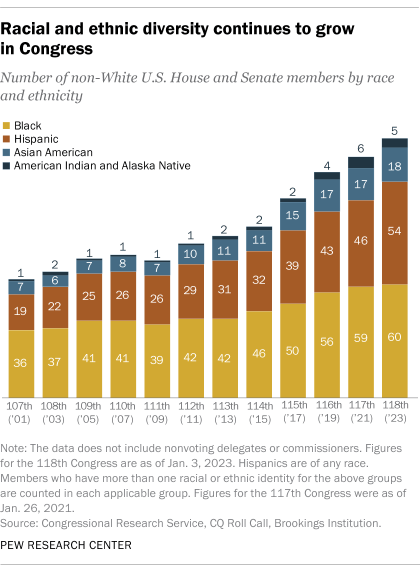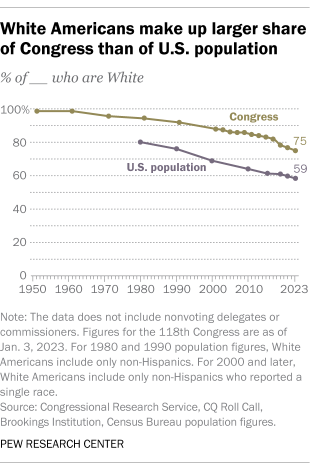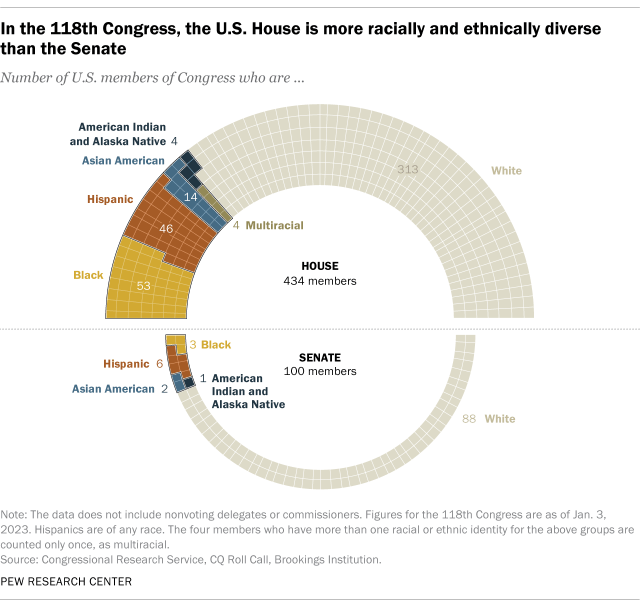A quarter of voting members of the U.S. Congress identify their race or ethnicity as something other than non-Hispanic White, making the 118th Congress the most racially and ethnically diverse to date. This continues a long-running trend toward more racial and ethnic diversity on Capitol Hill: This is the seventh Congress to break the record set by the one before it.

Overall, 133 senators and representatives today identify as Black, Hispanic, Asian American, American Indian or Alaska Native, according to a Pew Research Center analysis of data from the Congressional Research Service. This number has nearly doubled in the two decades since the 108th Congress of 2003-05, which had 67 minority members.
Our analysis of the 118th Congress reflects the 534 voting members of Congress as of Jan. 3, 2023. Portuguese American members are not included in the Hispanic count.
The vast majority (80%) of racial and ethnic minority members in the new Congress are Democrats, while 20% are Republicans. This split is similar to the previous Congress, when 83% of non-White lawmakers were Democrats and 17% were Republicans.
How we did this

Despite growing racial and ethnic diversity on Capitol Hill, members of Congress are still far more likely than the overall U.S. population to be non-Hispanic White (75% vs. 59%). This gap is about as wide as it was in 1981, when 94% of members of Congress were White, compared with 80% of the U.S. population.
In the new House of Representatives, 27 freshman members – including 19 Democrats and eight Republicans – are racial or ethnic minorities. In the last Congress, 16 freshman representatives – including seven Democrats and nine Republicans – were non-White.
Representation of some racial and ethnic groups in the House is now on par with their share of the total U.S. population, while others continue to lag behind. For example, 13% of House members are Black, about equal to the total share of Black Americans. And American Indians and Alaska Natives now make up about 1% of both the House and the U.S. population.

On the other hand, the share of Hispanic representatives in the House is much lower than the Hispanic share of the U.S. population (11% vs. 19%). Asian Americans, meanwhile, account for 4% of House members and 6% of the national population.
This analysis includes four representatives who have more than one racial or ethnic identity: Rep. Bobby Scott, D-Va., is counted as Black and Asian. Democratic Rep. Ritchie Torres of New York identifies as Black and Hispanic. Rep. Marilyn Strickland, D-Wash., is both the first Black lawmaker to represent the state and one of the first Korean American women to be elected to Congress. And Democratic Florida Rep. Maxwell Alejandro Frost, the first Generation Z member of Congress, is both Black and Hispanic.
When it comes to the upper chamber of Congress, 12 senators are members of a racial or ethnic minority group, up slightly from 11 in the 117th Congress. Six senators are Hispanic, two are Asian, three are Black and one is American Indian.
Four of the 12 non-White senators are Republicans: Tim Scott of South Carolina is Black, and Marco Rubio of Florida and Ted Cruz of Texas are both Hispanic. Markwayne Mullin of Oklahoma, a member of the Cherokee nation, is the first American Indian to serve in the Senate in almost two decades.






